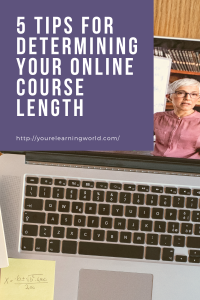 How long should my online course be? I get asked this A LOT!
How long should my online course be? I get asked this A LOT!
For now, here are 5 Tips to help you determine how long your online course should be. Use these to dial in the perfect length, while realizing one key aspect:
Your course should be long enough to deliver the learning outcomes your promise, and nothing more!
#1 Work backward by considering your learners first. This requires some research into their actual lifestyles.
The big question is how much time and willingness do they have to devote to your course?
Mandatory training that employees must complete during a paid workday is an entirely different course than say a masterclass on photography. Motivation, perceived benefit, investment of time, and a host of other elements will differ greatly depending on your audience.
Dig deep to understand who your learner is and what constraints they have. If your typical learner reports only 45 minutes of available time to devote to online training, you’ve already lost your audience by creating a lengthy 3-hour course.
#2 Next, focus on the subject matter. Gauge the complexity-based directly on your target audience.
To do this successfully, realize two key factors:
- Your (or your SMEs’) knowledge level of the topic is not your learner’s knowledge level. This is a common pitfall for course designers that begin creating courses without knowing their audience well enough. The course ends up being too complex and lengthy for beginners, or too redundant for those with advanced knowledge of the topic.
- There is often a big difference between what your learner wants vs what they need. Weigh these two factors carefully based on the end-user. If your ultimate goal is to sell your course to customers, your focus will likely be more centered on the perceived wants of your audience.
If your course is being created for an organization with specific learning objectives and skills/knowledge advancement, you’ll need to focus more on the actual needs of the learner.
#3 It may take lots of content to achieve your learning objectives. But, all of that content doesn’t necessarily need to be within your actual course.
Use supplements like worksheets, exercises, and outside resource links to flesh out the core concepts of your topic. This allows your audience to grasp the key objectives and then explore the nuances that either interests them or that they need additional instruction in.
This effectively broadens the scope of who your course is suitable for while keeping it from being a day-long epic.
#4 Make sure you have a detailed storyboard and a good grasp on the content you intend to include. I’ve seen courses go completely off the rails in terms of topic, length, and budget because the creator jumped right to the content creation stage.
To avoid overbuilding any one particular module, look at your course as a whole, and put time limitations and estimates on each learning objective. After all, if you’ve done your due diligence from Tip #1 (researching your audience), you’ll have a target length to work towards. This will help in not devoting all of your time to just a couple of your objectives.
#5 When in doubt, always lean towards shorter. Shorter chunks of content are better from an instructional design perspective (increased retention and engagement) and also err on the side of caution.
If you happen to misjudge your learner’s actual time/willingness to devote to your course, it is always better to leave them enough time to explore the additional content (from your supplements) as opposed to running out of time to grasp the core concepts.

Leave a Reply